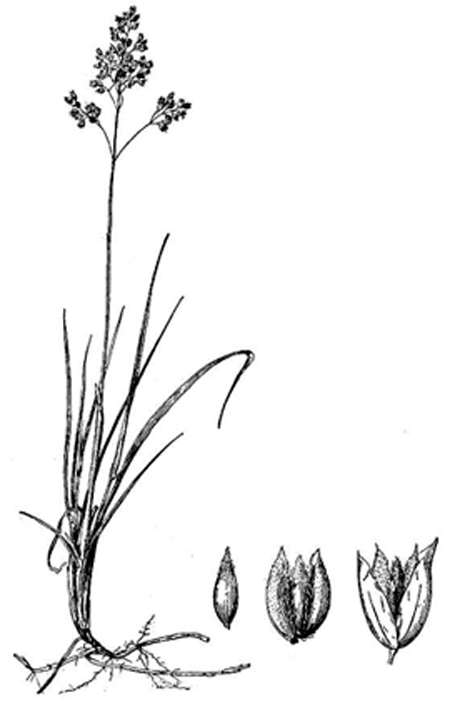Sweet Grass
Hierochloe odorata
Courtesy, Academy of Natural Sciences, Philadelphia
Illustration from A.S. Hitchcock (rev. A. Chase). 1950. Manual of the grasses of the United States. USDA Misc. Publ. No. 200. Washington, DC. 1950.
The culms, or stems, grow up to 30 inches in height. At lower right are closeups of the inflorescence.
Scientifically speaking, sweet grass is Hierochloe odorata (L.) Beauv. The generic title (pronounced high-row-clo-ee) is a Greek expression meaning “holy grass”; the specific epithet, odorata, (oh-doh-rate-a), means “fragrant.” It is native to the upper latitudes of the northern hemisphere from Alaska to Newfoundland and as far south as New England. “Beauv.” is the official abbreviation of the name of a French botanist and entomologist, Joseph Palisot, Baron de Beauvois (1752–1820).
For thousands of years sweet grass, known also by various other common names, has been used as incense in spiritual and religious ceremonies, as a personal perfume, and braided into necklaces and bracelets for wearing as amulets to ward off illness and injury. It has been applied as a topical medicament for superficial complaints and dermatological problems. It was once used in the making of baskets and mats. A long list of Native American uses will be found in Daniel E. Moerman’s Native American Ethnobotany (Portland, Oregon: Timber Press, 1998), 266-67.
The use of sweet grass by the American Indians was recorded throughout the Expedition journals. On 24 July 1806, Clark encountered a Crow Sun dance lodge on a Yellowstone River “Island thinly Covered with Cotton wood under which the earth which is rich is Covered with wild rye and a Species of grass resembling the bluegrass, and a mixture of Sweet grass which the Indian plat and ware around their necks for its cent which is of a Strong sent like that of the Vinella . . . .”
Sweet grass has a dark secret, too, which resides at the root of its beguiling fragrance. The chemical that makes it smell, when dried, like new-mown hay or vanilla, is coumarin, a powerful anticoagulent. Coumarin is found in small quantities in some fruits, including strawberries, apricots, and cherries. Under strict controls coumarin (commercially familiar as Coumadin) is used in the treatment of heart aliments. In large doses it is deadly, and thus serves as an effective rodent poison.
There are four other species of the genus, but this one is the most fragrant.

